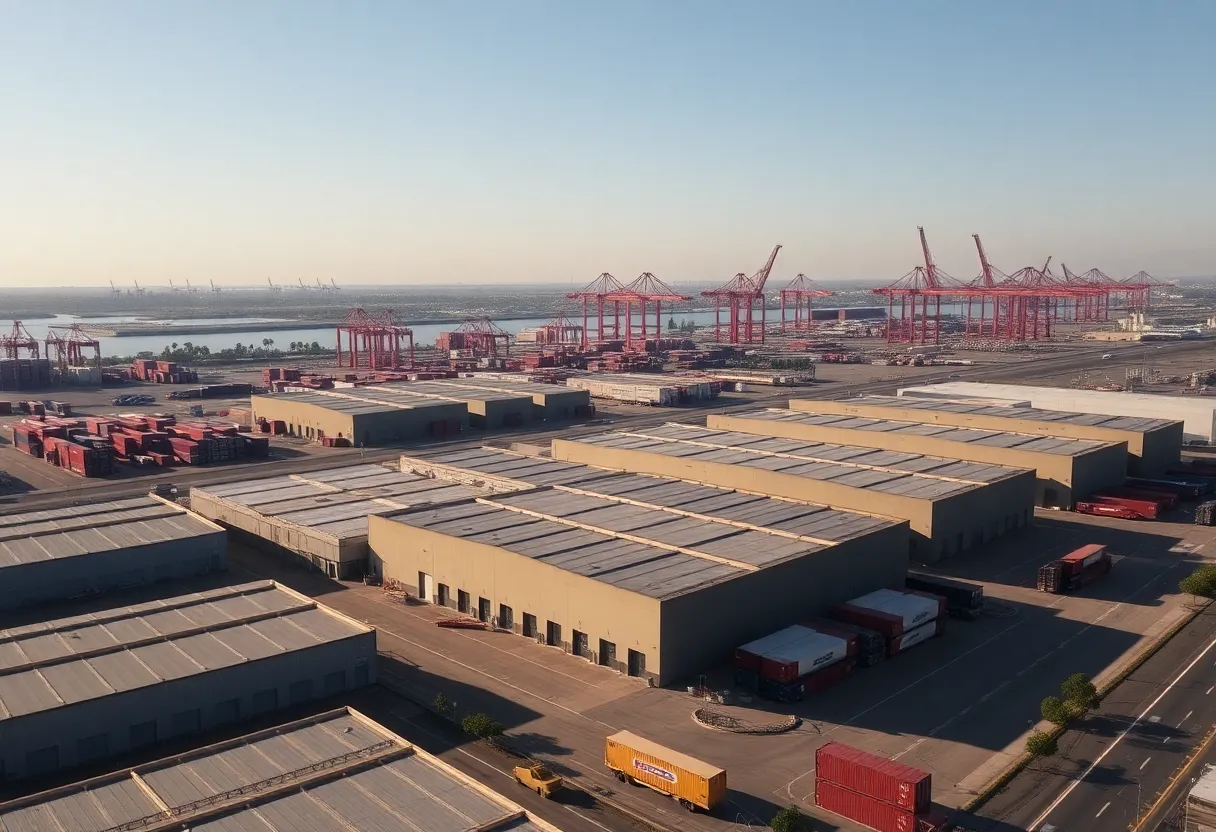Southern California, September 7, 2025
News Summary
Industrial real estate demand in Southern California faces challenges as President Trump’s tariffs lead to decreased leasing interest. Tariff increases, particularly on imports from China, Japan, and South Korea, contribute to economic uncertainty and a projected 25% reduction in imports. This situation has caused businesses to stall expansion plans while navigating fluctuating costs, potentially affecting market dynamics and economic growth by 2025. Despite some upticks in specific sectors, the overall outlook remains cautious due to macroeconomic uncertainties.
California
The demand for industrial real estate in Southern California is facing significant challenges as President Trump’s tariffs continue to weigh down the market. The potential for widespread tariffs has led to a decrease in interest for leasing warehouse space near the ports of Los Angeles County, which are vital for collecting and distributing imported goods.
Recently announced by the President, tariffs are set to increase to 125% on Chinese imports. Although a temporary delay of 90 days has been granted, the uncertainty surrounding these tariffs has caused many businesses to pause their leasing activities. As companies hold back on expansion decisions, the leasing of facilities has seen a temporary slowdown.
Economists predict that the tariffs could lead to a 25% drop in imports, which would have detrimental effects on the industrial market, including rising vacancy rates and a slowdown in new construction projects. With tariffs now including a 24% duty on goods from Japan and a 25% duty on imports from South Korea, trade in consumer goods—from electronics to apparel—that typically flows through regional warehouses is set to face disruptions. Unlike these countries, Canada and Mexico are exempt from baseline tariffs.
Furthermore, forecasts predict an $800 billion reduction in goods trade due to the tariffs, which could drastically reshape economic conditions by 2025. As businesses navigate this unpredictable landscape, many are adjusting their orders and operations in response to expected increases in product pricing.
The prevailing uncertainty around the tariff’s impact is also contributing to hesitancy among business owners regarding expansion plans. The decision-making process for tenants has delayed, as owners await clearer guidance on costs and demand. This scenario could lead to a lag in economic growth, particularly as real estate remains a crucial pillar of family-owned business legacies and future wealth-building strategies.
Despite these headwinds, there has been a recent uptick in demand for industrial properties across certain sectors, including aerospace and consumer goods distribution. Companies like Rexford Industrial Realty, a major player in Southern California’s industrial real estate market, own 425 properties totaling over 50 million square feet. Nevertheless, the market is emerging from a low point—a recent completion of new industrial properties was at a 10-year low, contributing to declining vacancy rates and rising rents.
Real estate analysts are navigating this cautious environment, suggesting that macroeconomic uncertainties continue to cloud the market’s outlook. With the fluctuations tied to tariff policies being unpredictable, economic growth predictions remain tenuous, reflecting the complexities of the current industrial landscape in Southern California.
Summary
- Demand for warehouses near Los Angeles County ports projected to decrease.
- Businesses are awaiting tariff outcomes, leading to slowed leasing.
- Tariffs have increased to 125% on certain imports, causing uncertainty.
- Predictions indicate a 25% drop in imports, impacting the industrial market.
- Duties imposed on goods from Japan and South Korea; Canada and Mexico are exempt.
- Businesses adjusting orders due to cost uncertainties related to the tariffs.
FAQ Section
What are Trump’s tariffs affecting?
The tariffs are primarily affecting the import of consumer goods and the leasing of industrial warehouse space in Southern California.
How much is the expected drop in imports due to these tariffs?
Forecasts predict a 25% drop in imports by 2025 as a result of the tariffs.
Which countries are facing increased tariffs?
Imports from Japan face a 24% tariff, while those from South Korea have a 25% duty applied, while Canada and Mexico are exempt from these tariffs.
How may the industrial real estate market be impacted?
The industrial market could see rising vacancy rates, a slowdown in new construction, and increased difficulty for businesses to expand due to tariff-related uncertainties.
Key Features Overview
| Feature | Details |
|---|---|
| Tariff Increase on Imports | 125% on Chinese imports, 24% on Japanese goods, 25% on South Korean goods, Canada and Mexico exempt. |
| Economic Impact | Expected 25% decline in imports, $800 billion reduction in goods trade by 2025. |
| Industrial Market Effects | Rising vacancy rates, declining new construction, and businesses delaying expansion. |
| Recent Trends | Some sectors, like aerospace and consumer goods distribution, showing an uptick in demand. |
| Market Sentiment | Real estate analysts maintain a cautious outlook amid macroeconomic uncertainties. |
Deeper Dive: News & Info About This Topic
- OC Register: The Real Estate Journey of a Family-Owned Businesses
- LA Times: Tariffs Chill Southern California’s Vast Industrial Property Market
- Seeking Alpha: Rexford Industrial Realty – Pure Play on the SoCal Industrial Real Estate Rebound
- CNBC: Elliott Sees Opportunities to Create Value at Warehouse REIT Rexford Industrial
- Wikipedia: Industrial Real Estate

Author: STAFF HERE SAN DIEGO WRITER
The SAN DIEGO STAFF WRITER represents the experienced team at HERESanDiego.com, your go-to source for actionable local news and information in San Diego, San Diego County, and beyond. Specializing in "news you can use," we cover essential topics like product reviews for personal and business needs, local business directories, politics, real estate trends, neighborhood insights, and state news affecting the area—with deep expertise drawn from years of dedicated reporting and strong community input, including local press releases and business updates. We deliver top reporting on high-value events such as Comic-Con International, San Diego County Fair, and San Diego Pride Festival. Our coverage extends to key organizations like the San Diego Regional Chamber of Commerce and United Way of San Diego County, plus leading businesses in biotechnology, healthcare, and technology that power the local economy such as Qualcomm, Illumina, and Scripps Health. As part of the broader HERE network, including HEREAnaheim.com, HEREBeverlyHills.com, HERECostaMesa.com, HERECoronado.com, HEREHollywood.com, HEREHuntingtonBeach.com, HERELongBeach.com, HERELosAngeles.com, HEREMissionViejo.com, and HERESantaAna.com, we provide comprehensive, credible insights into California's dynamic landscape.





